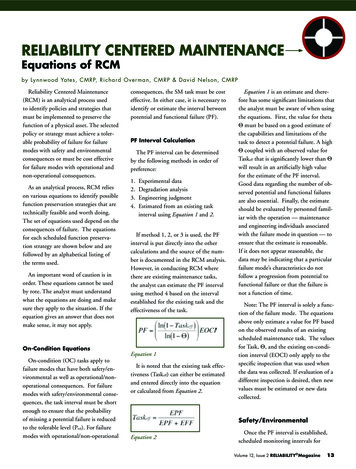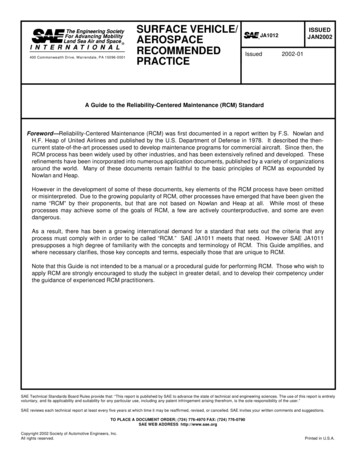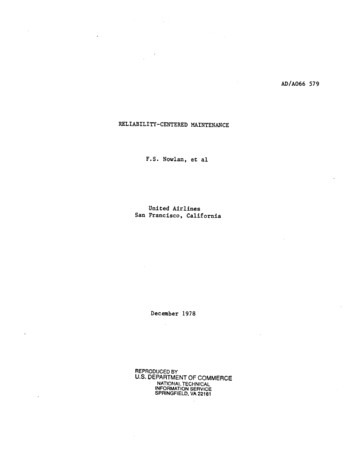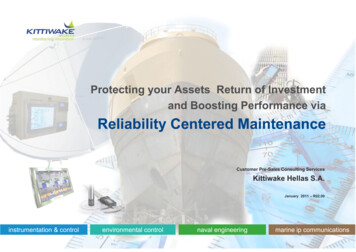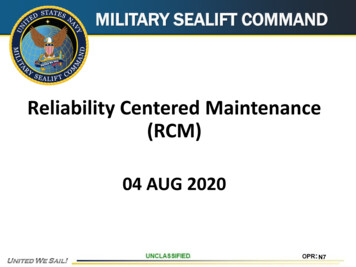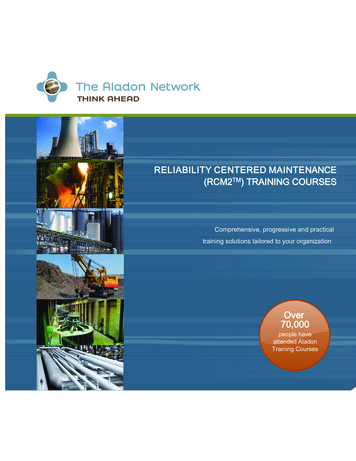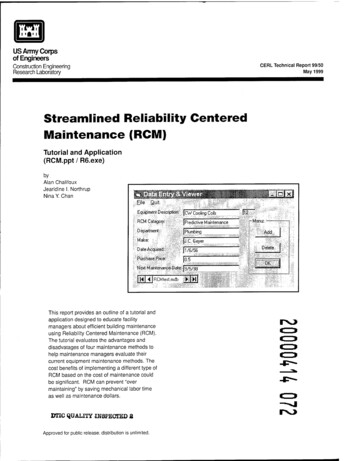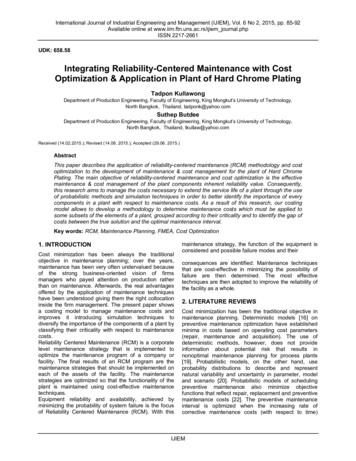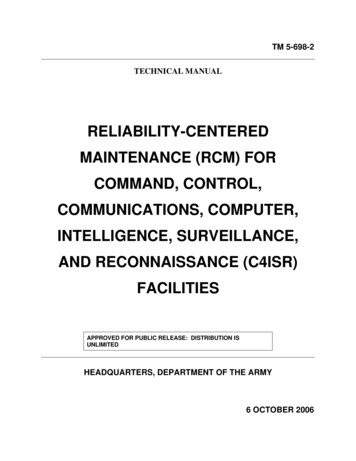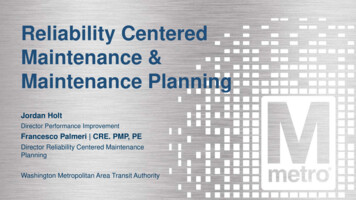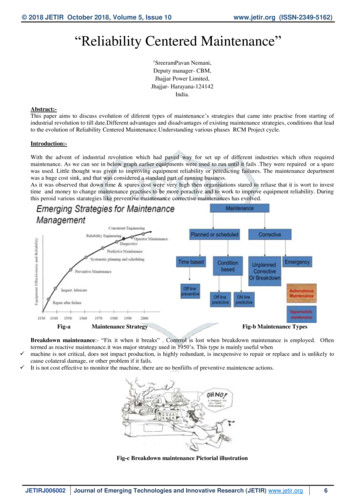
Transcription
2018 JETIR October 2018, Volume 5, Issue 10www.jetir.org (ISSN-2349-5162)“Reliability Centered Maintenance”1SreeramPavan Nemani,Deputy manager- CBM,Jhajjar Power Limited,Jhajjar- Harayana-124142India.Abstract:This paper aims to discuss evolution of diferent types of maintenance’s strategies that came into practise from starting ofindustrial revolution to till date.Different advantages and disadvantages of existing maintenance strategies, conditions that leadto the evolution of Reliability Centered Maintenance.Understanding various phases RCM Project cycle.Introduction:With the advent of industrial revolution which had paved way for set up of different industries which often requiredmaintenance. As we can see in below graph earlier equipments were used to run until it fails .They were repaired or a sparewas used. Little thought was given to improving equipment reliability or peredicting failures. The maintenance departmentwas a huge cost sink, and that was considered a standard part of running business.As it was observed that down time & spares cost were very high then organisations stared to reliase that it is wort to investtime and money to change maintenance practises to be more poractive and to work to improve equipment reliability. Duringthis peroid various starategies like preventive maintenance corrective maintenances has evolved.Fig-a Maintenance StrategyFig-b Maintenance TypesBreakdown maintenance:- “Fix it when it breaks” . Contrrol is lost when breakdown maintenance is employed. Oftentermed as reactive maintenance.it was major strategy used in 1950’s. This type is mainly useful whenmachine is not critical, does not impact production, is highly redundant, is inexpensive to repair or replace and is unlikely tocause colateral damage, or other problem if it fails.It is not cost effective to monitor the machine, there are no benfiifts of preventive maintencne actions.Fig-c Breakdown maintenance Pictorial illustrationJETIRJ006002Journal of Emerging Technologies and Innovative Research (JETIR) www.jetir.org6
2018 JETIR October 2018, Volume 5, Issue 10 www.jetir.org (ISSN-2349-5162)Preventive Maintenance(PM):- “Perform regular overhauls so that the machine will not fail”. It is a schedule of plannedmaintenance actions aimed at the prevention of breakdowns and failures. The primary goal is to prevent the failure of theequipmnet before it actually occurs It is designed to enhance equipment relaibility by replacing worn components before theyactually failAfter deploying this strategy quipment breakdowns were reduced but not considerably.Preventive maintenance Is mainly useful when.Machine or componnet wears out or degrades in known amount of time.Risk of inagant mortality is less than risk of failure.Cost of Preventive maintenance action is less than the cost of failure.Condition maonitoring is not vailble.To date it is still religously being followed one of the maintencne practises industry as it was observed even after going forPM still number of failures were high which has lead to evolution of Preventive maintenance/Relaiability MaintenancePredictive Maintenance:- “If it ain’t broke, don’t fix it”. Rotating machinery will give indicative signals before it fails basicon type of equipment various Preventive maintenance technologies like Vibration analysis, MCSA, Tribology, ParameterMonitoring,IR Thermal imaging.Ultrasonic leak detection were being usedProactive maintenance:-Fig-d Proactive maintenance Pictorial illustration A proactive maintenance program is the capstone of RCM philosophy. It provides a logical culmination to the other typesof maintenance described before i.e. reactive, preventive, and predictive).Proactive maintenance improves maintenance through better design, installation, maintenance procedures, workmanship, andscheduling.Proactive maintenance is characterized by the following attitudes:Maintaining a feedback loop from maintenance technicians to designers, in an attempt to ensure that design mistakes made inthe past are not repeated in future designs.Viewing maintenance and supporting functions from a life-cycle perspective.This perspective will often show that cutting maintenance activities to save money in the short term often costs more money inthe long term.Constantly re-evaluating established maintenance procedures in an effort to improve them and ensure that they are beingapplied in the proper mix.Proactive maintenance uses the following basic techniques to extend machinery life·Proper installation and precision rebuild: e.g. Performance testing & vibration, alignment and balancing criteria.Failed-parts analysis.Root-cause failure analysisReliability engineering: Failure rate/MTBF, Weibull distribution.Age exploration: use of ‘Gut-feeling’ to asses the condition of part on each inspection & slowly increasing inspection intervalprovided same fitter/elctr. perform that task.Recurrence control.JETIRJ006002Journal of Emerging Technologies and Innovative Research (JETIR) www.jetir.org7
2018 JETIR October 2018, Volume 5, Issue 10www.jetir.org (ISSN-2349-5162)RCM Introduction:On December 29th, 1978 F. Stanley Nowlan and Howard F. Heap published report number A066-579, "Reliability-CenteredMaintenance". The report was the culmination of several years of work aimed at determining a new, more cost effective wayof maintaining complex systems. The called it Reliability- Centered Maintenance (RCM) because programs developedthrough RCM "are centered on achieving the inherent safety and reliability capabilities of equipment at a minimum cost".RCM is a time consuming, resource intensive process. Many practitioners have tried to reduce the amount of time andresources required to accomplish RCM projects with varying degrees of success.The Definition of ReliabilityIn the book Maintainability, Availability, and Operational Readiness Engineering Dimitri Kececioglu definesreliability as:"The probability that a system will perform satisfactorily for given period of time under stated conditions."Nowlan and Heap define Inherent Reliability as:" the level of reliability achieved with an effective maintenance program. This level is established by the design ofeach item and the manufacturing processes that produced it. "When we look at these definitions in conjunction it becomes very evident that any asset management program must addresssystem development through all phases of a systems life. There is no maintenance program that can improve the reliability ofa poorly designed system. Additionally, whatever maintenance program is developed is determined by the design of thesystem and the goals of the organization.Fig-e QuestionearThe Seven Questions of RCMThere are seven basic questions used to help practitioners determine the causes of system failures and develop activitiestargeted to prevent them. The questions are designed to focus on maintaining the required functions of the system.1. What are the functions of the asset?2. In what way can the asset fail to fulfill its functions?3. What causes each functional failure?4. What happens when each failure occurs?5. What are the consequences of each failure?6. What should be done to prevent or predict the failure?7. What should be done if a suitable proactive task cannot be found?What Are The Functions of the Asset?Every facility is uniquely designed to produce some desired output. Within every RCM analysis we have two types offunctions. First, the Main or Primary function, this function statement will describe the reason we have acquired this asset andthe performance standard we expect it to maintain. Second, are the Support Functions, which list the function of eachcomponent or maintainable item that makes up the system. The Support Functions are provided by the bottom level ofequipment in most facilities such as pumps, electric motors, valves, rollers, etc. Each of those maintainable items has one ormore easily identifiable functions that enable the system to produce its required output. It is the loss of these functions thatlead to variation in the Main or Primary function of the system and the safety, environmental, operational, and profit output ofthe facility.JETIRJ006002Journal of Emerging Technologies and Innovative Research (JETIR) www.jetir.org8
2018 JETIR October 2018, Volume 5, Issue 10www.jetir.org (ISSN-2349-5162)Fig f - Functional HirerchayIn What Way Can the Asset Fail to Fulfill its Functions?Nowlan and Heap said there are two types of failures. There are functional failures and potential failures. Functionalfailures are usually found by operators, and potential failures are usually found by maintenance personnel. In manyorganizations there are great debates about what constitutes a failure. In their original work Nowlan and Heap used avery good definition for failure. “A failure is an unsatisfactory condition.” Using this definition allows us to grasp theidea that equipment can continue to operate yet be considered failed. Many condition monitoring programs don’tachieve their desired output because those running the program do not recognize that a failure has occurred assoon as an unsatisfactory condition is detected. They often try to run the equipment as long as possible or until they getcloser to the F of the P- F curve. At Allied Reliability we call this “managing to the F”. More mature programs manageto the P, meaning that they take action as soon as the unsatisfactory condition is recognized. Remember, the further wego along the P-F curve the higher the level of business risk we are accepting. It is equally important to recognize thatthere is significant value in ensuring that equipment is installed and commissioned properly.Fig-g IPF CurveThe I-P-F curve shown above is the standard P-F curve with an I-P portion added. Point I is defined as the point ofinstallation of the component. The I-P portion of the I-P-F curve is the failure free period. This is the time during whichthe operation is defect free. The I-P interval for machines that were installed improperly may be just a few seconds. TheI-P interval for machines installed by well trained crafts people using well designed procedures, precisiontechniques, and precise measuring equipment, and commissioned by operators using well designed operatingprocedures may be years.The graphic above shows what the I-P-F curve for two differently installed identical machines might look like. Themachine with the longer I-P interval was installed by well trained crafts personnel using a properly designed procedureand precision measuring devices, and commissioned by operators using a well designed operating procedure. Themachine with the shorter I-P interval was installed by inadequately trained personnel using either no procedure or apoorly designed procedure without precision measuring devices and techniques, and commissioned by operatorsusing either no procedure or a poorly designed procedure. The difference in lengths of the I-P portions of the curve forthe two pieces of equipment may represent large sums of money. The dollars represent the additional cost of parts andlabor and also the amount of additional foregone production as a result of the extra maintenance work that had to beperformed.Looking at an organization’s shift in focus from F toward I is a more effective way to determine its maturity than bylooking at the age of their maintenance program. Many organizations reactively maintain equipment for a long time.JETIRJ006002Journal of Emerging Technologies and Innovative Research (JETIR) www.jetir.org9
2018 JETIR October 2018, Volume 5, Issue 101.2.3.4.www.jetir.org (ISSN-2349-5162)An organization that is constantly focused on Point F and staying clear of it, will undoubtedly be a reactive culture.Typical things heard around this organization might be “How long can we run it before it fails?” and “Just how bad isit?”.An organization’s first step toward maturity will be to shift its focus from Point F to Point P. The organization thenfocuses its efforts on understanding how things fail and their ability to detect these failures early. Typical thingsoverheard in this organization may be something like: “Is this the best way to detect these defects early?” or “Iappreciate you letting me know about this problem, even though it’s very early.”Further maturation results in a transition from focusing on Point P to focusing on Point I. Overheard in the hallways ofthis organization are things like “Take the time to do it right, it will pay big dividends for us not too far down the road”and “Let’s update the procedures for that job to reflect what we just learned”. This organization is trying to preventfailures from occurring in the first place by applying best practices with fits, tolerances, alignment standards,contamination control and well documented procedures. They will see the step change in performance and they are theones we label “mature” not the organizations that have been doing it poorly but for a longer period of time.Thefunctional failure statement describes the loss of the equipment’s function, not what is wrong with the equipment.A good functional failure statement will most likely not have the noun name of an equipment part in it.What Causes Each Functional Failure?At the end of the day we will be building maintenance tasks designed to prevent functional failures from occurring. Inorder to do this we must understand what causes each functional failure. The cause may be the failure of someequipment part, but it can just as easily be a failure in some human activity. Improper operation and impropermaintenance are likely to be the causes of failures. Remember the definition of a system. Everything and everybody inthe facility has some impact on system reliability.It is very important to describe these causes or failure modes in a way that allows us to create a living program forimproving asset management. Easy to use codes in the Enterprise Asset Management (EAM) system will allow us tocapture data about what types of failures are occurring and to react to that data by reengineering the maintenanceplan, training plan, or equipment design associated with the equipment. A well designed Failure Reporting, Analysis,and Corrective Action System (FRACAS) is a must for continuously improving system performance.For part failureswe may want to use a simple three part code that consists of the part name, part defect, and defect cause.What Happens When Each Failure Occurs?Known as Failure Effects, these statements clearly describe what happens when a failure occurs and what eventsare required to bring the process back to normal operating conditions. Different things can happen when a failureoccurs. Not all failures are created equal. When listing failure effect statements we should fulfill the following criteria:Events that led up to the failure – Any immediate notable effects of wear or imminent failureFirst Sign of Evidence – Is the failure evident to the operating crew as they perform their normal duties? If so explainhow.Secondary Effects – The effects of failure on the next higher indenture level under consideration.Events Required to Bring the Process Back to Normal Operating conditions.What Are the Consequences of Each Failure?What makes failures matter is their impact on the business. Every business has goals for profitability, safetyperformance, environmental performance, and operational performance. Each failure has a different impact on businessperformance, and it is important for the RCM team to understand the consequences of each one. Some failures are oflittle to no consequence, and some can result in the loss of lives, or in extreme cases total failure of the business.Mostorganizations use some sort of severity matrix to define the consequences of failures. The tables below represent justsome of the ways this can be done.RCM Project Cycle:After deciding to start RCM project, It is important to train the members on various technologies of RCM how toimplement them, Next comes selection of team, It is very important function of RCM manager to get buy back frommanagement.System to be developed to know existing level (KPI) so that without knowing where we stand it would be difficult tocapture benefits gained.After Finalising the KPI’s And measuring them a realistic target to be developed with methodology upon whichimplementing the desired gains would be achieved and qualtifying the target and presenting to the management is mustto get buy back from management.The timelines of different pahses to be fixed and periodically reviewed by the top management to keep focus on entireRCM projectExperienced RCM project managers typically structure an RCM project into four phases that mustbe accomplished to fully perform RCM. These phases, as shown in Figure h are:a. Decision – Justification and planning based on need, readiness and desired outcomes.b. Analysis – Conduct the RCM study in a way that provides a high quality output.c. Implementation – Act on the study’s recommendations to update asset andmaintenance systems, procedures and design improvements.d. Benefits – Measure the improvements and identify opportunities to further improve.JETIRJ006002Journal of Emerging Technologies and Innovative Research (JETIR) www.jetir.org10
2018 JETIR October 2018, Volume 5, Issue 10www.jetir.org (ISSN-2349-5162)Fig-h (Four Phases of RCM Project)Fig-I (Phases timeline of RCM project for early impact)Time lines for each phase to be decided before starting of RCM project and individually monitored which will help tokeep track on phase of development and to plan, to bring more focus towards project.Fig-J The above figure J clearly shows RCM project process in brief.After completion of project. Gains to be tabulated and to be presented to the management so that it will encourageothers also to take up RCM projects. Sustainence of RCM project is crutial action plan to be made to check thesustainence of the completed RCM project and good practises to be communicated to all.By doing so we can minimisethe maintenance cost and improve the reliability of equipment’s.References:1. Nowlan, Stanley F. and Heap, Howard F. Reliability Centered Maintenance. San Francisco: DolbyAccess Press, 1978.2. Smith, Anthony M. and Hinchcliffe, Glenn R. RCM: Gateway to World Class Maintenance. Oxford: ButterworthHeinemann, 2003; ISBN 9780750674614.JETIRJ006002Journal of Emerging Technologies and Innovative Research (JETIR) www.jetir.org11
2018 JETIR October 2018, Volume 5, Issue 10www.jetir.org (ISSN-2349-5162)3. The Association for Maintenance Professionals. Certified Reliability Leader Passports and Complete Body ofKnowledge, ISBN MMCRLBOK, MRO Zone bookstore.4. Reliabilityweb.com. Uptime Elements -A Reliability System for Asset Performance Management.5. RCM Overview Workshop at 2004 SMRP Conference.6. RCM Key Performance Indicators Workshop at the 2009 Reliability Centered MaintenanceManagers Forum. www.maintenanceconference.comJETIRJ006002Journal of Emerging Technologies and Innovative Research (JETIR) www.jetir.org12
The called it Reliability- Centered Maintenance (RCM) because programs developed through RCM "are centered on achieving the inherent safety and reliability capabilities of equipment at a minimum cost". RCM is a time consuming, resource intensive process. Many
